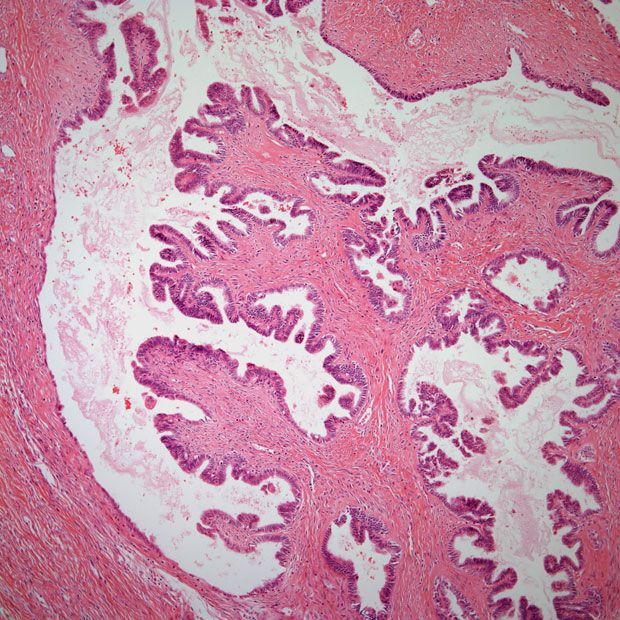Rinatabart Sesutecan Earns FDA FTD in Platinum-Resistant Ovarian Cancer
Investigators are assessing the safety and antitumor activity of rinatabart sesutecan in advanced epithelial ovarian cancer as part of the phase 1/2 PRO1184-001 study.
The safety and antitumor activity of rinatabart sesutecan is currently under investigation as part of the phase 1/2 PRO1184-001 study (NCT05579366) in those with select locally advanced and/or metastatic solid tumors, including patients with epithelial ovarian cancer, endometrial cancer, non–small cell lung cancer, breast cancer, and mesothelioma.

The FDA has granted fast track designation to rinatabart sesutecan (Rina-S; PRO1184) as a therapy for those with folate receptor alpha (FRα)–expressing, high-grade, endometrioid or serous platinum-resistant ovarian cancer, according to a press release from ProfoundBio.1
“Our receipt of fast track designation from the FDA underscores our belief in the tremendous promise of [rinatabart sesutecan] as a potential best-in-class FRα antibody-drug conjugate [ADC] to address the significant need for improved treatment options for advanced ovarian cancer,” Naomi Hunder, chief medical officer of ProfoundBio, said in the press release.1 “FRα is a highly prevalent antigen in ovarian cancer and [rinatabart sesutecan] has shown encouraging antitumor activity and tolerability in our phase 1 dose escalation study in [patients with] ovarian and endometrial cancer across the full spectrum of FRα expression. We look forward to working closely with the FDA as we progress further clinical development and registrational studies for [rinatabart sesutecan].”
The safety and antitumor activity of rinatabart sesutecan is currently under investigation as part of the phase 1/2 PRO1184-001 study (NCT05579366) in those with select locally advanced and/or metastatic solid tumors, including patients with epithelial ovarian cancer, endometrial cancer, non–small cell lung cancer, breast cancer, and mesothelioma.
According to findings presented at the 2023 Society for Immunotherapy of Cancer Annual Meeting (SITC), treatment with rinatabart sesutecan elicited an objective response rate (ORR) of 67% (n = 8/12) among evaluable patients with ovarian and endometrial cancer with FRα expression of more than 1% in their tumors.2 This included 3 partial responses (PRs) in patients whose FRα expression was less than 25% per 1+ immunohistochemistry staining intensity. Responses generally appeared to deepen over time at doses ranging from 60 mg/m2 to 140 mg/m2, which included a complete response (CR) in 1 patient with ovarian cancer who received 2 doses of rinatabart sesutecan, as well as prior treatment with mirvetuximab soravtansine (Elahere).
Treatment with rinatabart sesutecan appeared to be tolerable across all doses, although the 140 mg/m2 dose level was still under assessment as a possible maximum tolerated dose at the time of the analysis. Treatment-related adverse effects (TRAEs) were typically grade 1 or 2 and considered manageable; common TRAEs included cytopenias, gastrointestinal toxicities, and fatigue. Investigators reported no instances of interstitial lung disease, pneumonitis, infusion-related reactions, or corneal toxicity.
“We believe [rinatabart sesutecan’s] encouraging phase 1 activity and safety data are differentiated within the landscape of emerging targeted therapies for ovarian and endometrial cancers, as [rinatabart sesutecan] elicited robust responses at well-tolerated doses in heavily pretreated patients, including in tumors expressing low levels of FRα,” Hunder said in a press release on these data.2
In the phase 1/2 PRO1184-001 trial, patients received rinatabart sesutecan monotherapy intravenously at escalating doses in part A and will be treated at the recommended dose in part B. Investigators are currently enrolling patients across multiple sites in the United States and China for part B of the trial.
The trial’s primary end points include treatment-emergent AEs and dose-limiting toxicity. Secondary end points include ORR, disease control rate, progression-free survival, overall survival, and duration of response.
Patients with histologically or cytologically confirmed metastatic or unresectable solid malignancies, including those with epithelial ovarian cancer, primary peritoneal cancer, or fallopian tube cancer, are able to enroll on the trial. Additional enrollment criteria include having an ECOG performance status of 0 or 1 and measurable disease based on RECIST v1.1 criteria.
References
- ProfoundBio announces rinatabart sesutecan FDA fast track designation for patients with advanced ovarian cancer. News release. ProfoundBio. January 5, 2024. Accessed January 11, 2024. https://rb.gy/r84rz1
- ProfoundBio presents promising data on ADC programs, including early clinical results of rinatabart sesutecan in ovarian and endometrial cancers, at SITC 2023. News release. ProfoundBio. November 3, 2023. Accessed January 11, 2024. https://rb.gy/sxh3d5
Newsletter
Stay up to date on recent advances in the multidisciplinary approach to cancer.